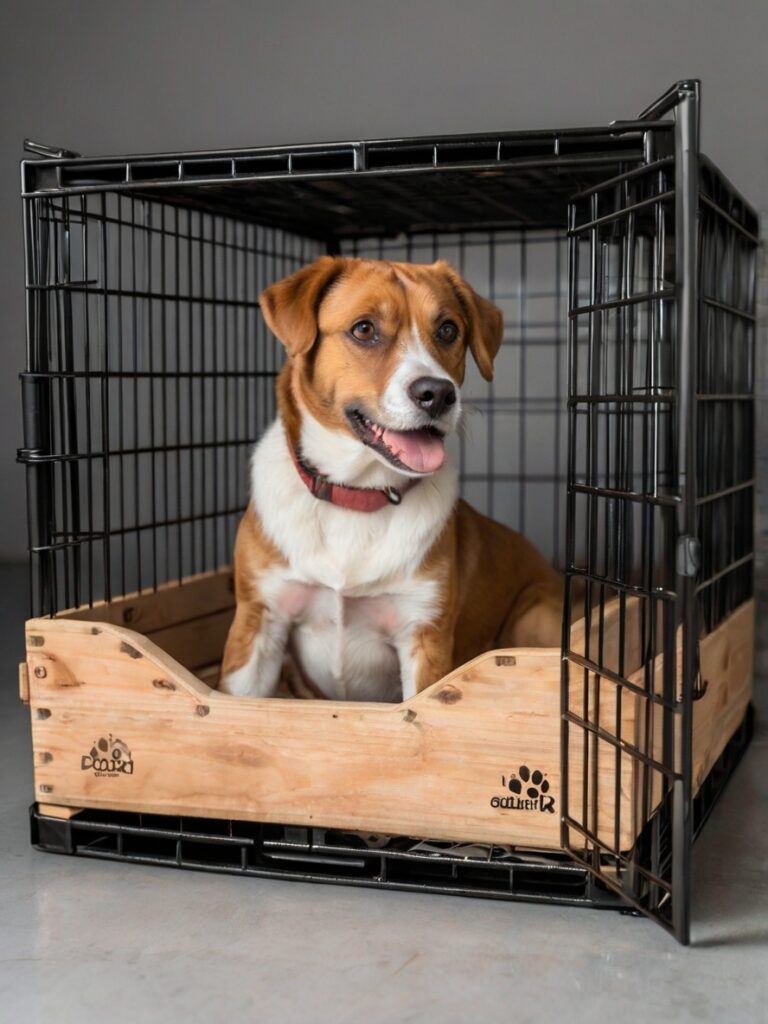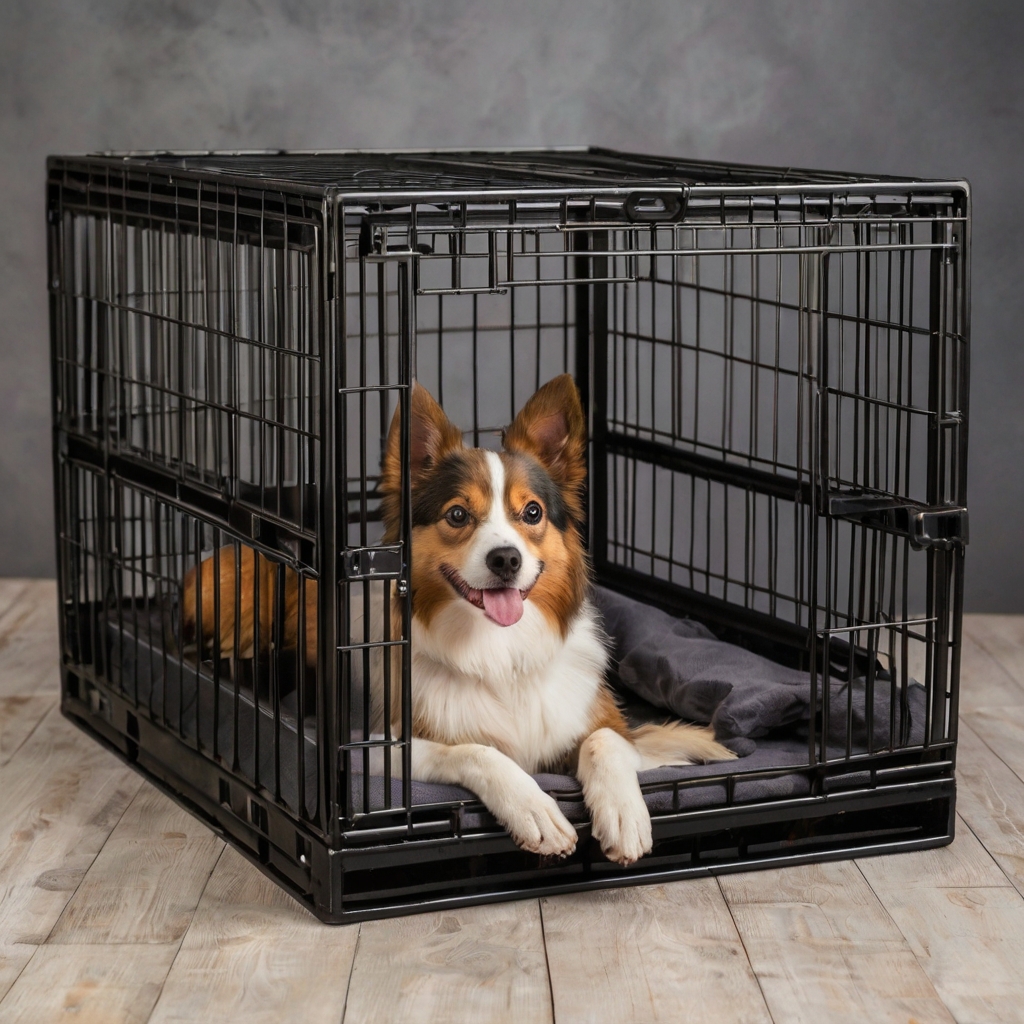SAVE RECIPE
Dog Crate , Crate training is one of the most effective ways to provide your dog with a safe and comfortable space that also supports house training and behavior management. A dog crate serves as a personal den, offering your pet a place to relax, feel secure, and sleep. It can also help with travel safety, keeping your dog confined during car rides or when you’re away from home.
In this guide, we’ll explore the different types of dog crates, the benefits of using a crate, how to choose the right size, and tips on how to make crate training a positive experience for your dog.
Why Use a Dog Crate?
Using a crate for your dog has numerous benefits that extend beyond providing a cozy space to sleep. Crates are valuable tools for house training, preventing destructive behavior, and ensuring your dog’s safety while you’re out or traveling. Let’s look at some key advantages of crate training:
1. House Training
Crate training is one of the most effective methods for housebreaking puppies. Dogs naturally avoid soiling their sleeping area, so using a crate can help establish a consistent bathroom routine and prevent accidents inside the house.
2. Preventing Destructive Behavior
Dogs, especially puppies, tend to chew on furniture, shoes, and other household items when left unsupervised. A crate offers a safe space where they can stay without getting into trouble, protecting your belongings and keeping your dog out of harm’s way.
3. Providing a Safe Space
A crate mimics a den-like environment that many dogs find comforting. It provides a personal space where they can retreat to when they feel anxious, tired, or need some quiet time.
4. Travel Safety
Crates are essential for safe travel, whether in the car or on an airplane. A crate ensures your dog stays confined and comfortable, reducing the risk of injury or distraction during travel.
5. Helping with Separation Anxiety
Dogs with separation anxiety can benefit from crate training as it gives them a secure space to rest when you’re not at home. A crate provides structure and can help ease anxiety by creating a predictable and calming environment.

Types of Dog Crates
There are various types of dog crates available, each with its unique features and benefits. Choosing the right one depends on your dog’s size, behavior, and specific needs. Let’s explore the most common types of dog crates:
1. Wire Dog Crates
Wire crates are one of the most popular options due to their durability and visibility. They provide plenty of ventilation and allow your dog to see their surroundings, which can help reduce anxiety.
Pros:
- Good ventilation and visibility
- Foldable for easy storage and transport
- Removable tray for easy cleaning
- Suitable for all sizes of dogs
Cons:
- Not as aesthetically pleasing as other options
- Some dogs may feel exposed in a wire crate
Best For: Dogs who don’t mind being able to see their surroundings and need a durable, well-ventilated space.
2. Plastic Dog Crates
Plastic crates are often used for travel because they are enclosed, providing a more den-like environment. They are sturdy and ideal for dogs who prefer more privacy or feel anxious in open spaces.
Pros:
- Enclosed design provides more privacy
- Sturdy and durable for travel
- Meets airline regulations for pet carriers
- Good insulation for cooler climates
Cons:
- Less ventilation compared to wire crates
- Bulky and harder to store
Best For: Dogs who prefer a more enclosed space or need a crate for air travel.
3. Soft-Sided Dog Crates
Soft-sided crates are lightweight and portable, making them great for travel or for use in temporary locations, such as camping trips. They are made of fabric with mesh panels for ventilation and visibility.
Pros:
- Lightweight and easy to carry
- Easy to set up and fold down
- Comfortable for short-term use or travel
Cons:
- Not suitable for dogs who chew or scratch
- Less durable than plastic or wire crates
Best For: Calm dogs who need a lightweight, portable option for short trips or temporary crate use.
4. Heavy-Duty Dog Crates
Heavy-duty crates are designed for strong or escape-prone dogs. These crates are made from reinforced materials like steel to withstand chewing, scratching, and attempts to break out.
Pros:
- Extremely durable and escape-proof
- Suitable for large, strong, or anxious dogs
- Provides a secure environment
Cons:
- Heavier and more expensive than other crates
- Can be bulky and harder to move
Best For: Large or strong dogs, or dogs with a history of escaping from standard crates.
5. Furniture-Style Crates
Furniture-style crates, also known as dog crate furniture, are designed to blend in with your home decor. They look like pieces of furniture, such as end tables or cabinets
, while doubling as a functional dog crate. These crates are ideal for dog owners who want a stylish, multi-purpose crate that complements their interior design.
Pros:
- Blends with home decor
- Multi-functional (can be used as a table or storage space)
- Provides a cozy, enclosed space for your dog
Cons:
- More expensive than standard crates
- Not suitable for dogs who chew or scratch
Best For: Dog owners who want a crate that serves as both a functional dog space and a piece of furniture.
How to Choose the Right Crate Size
Selecting the right size of crate for your dog is essential to ensure comfort and safety. Your dog should have enough space to stand, turn around, and lie down comfortably without feeling cramped. Here’s a step-by-step guide to help you choose the correct size:
- Measure Your Dog: Measure your dog’s length from the tip of their nose to the base of their tail, and their height from the floor to the top of their head or ears (whichever is taller).
- Add Extra Space: Add 2-4 inches to both the length and height measurements to ensure enough space for comfort. This will allow your dog to move freely without feeling restricted.
- Avoid Oversizing: While it’s important to provide enough space, don’t choose a crate that’s too large. A crate that is too spacious may encourage your dog to use one side as a bathroom, which defeats the purpose of house training.
- Puppies: If you’re buying a crate for a puppy, consider getting a larger crate with a divider panel. This way, you can adjust the crate’s size as your puppy grows, preventing the need to purchase multiple crates.
Crate Training Tips for Success
Crate training is most effective when it’s done in a positive and gradual manner. Here are some tips to help make the process smooth and enjoyable for both you and your dog:
- Make It Comfortable: Line the crate with a soft, comfortable bed or blanket to create a cozy environment. Place your dog’s favorite toys or treats inside to encourage them to enter the crate voluntarily.
- Start Slowly: Introduce the crate slowly by allowing your dog to explore it at their own pace. Leave the door open at first, and let them go in and out without feeling trapped.
- Positive Reinforcement: Use treats and praise when your dog enters the crate willingly. This helps create a positive association with the crate.
- Gradual Duration: Begin by having your dog spend short periods of time in the crate, gradually increasing the duration as they become more comfortable.
- Create a Routine: Establish a consistent routine for using the crate, such as during meals, rest time, or when you leave the house. Dogs thrive on routine, and a predictable schedule can make crate training easier.
- Avoid Using the Crate as Punishment: Never use the crate as a form of punishment, as this can create negative associations with the crate and make your dog anxious or fearful of it.
- Exercise Before Crate Time: Ensure your dog gets plenty of exercise before crate time. A tired dog is more likely to settle down and relax in their crate.
- Don’t Leave Them Too Long: Avoid leaving your dog in the crate for extended periods. Puppies, in particular, need frequent potty breaks and exercise. Adult dogs shouldn’t be crated for more than 4-6 hours at a time during the day.
Crate Maintenance and Cleaning
To ensure your dog’s crate remains a safe and hygienic space, regular cleaning is essential. Here are some tips for maintaining and cleaning your dog’s crate:
- Clean the Tray: For wire crates with removable trays, clean the tray regularly with mild soap and water. This helps prevent the buildup of dirt and odors.
- Wash Bedding: If you use a crate bed or blanket, wash it frequently to keep the crate fresh and comfortable.
- Disinfect the Crate: Use pet-safe disinfectants to clean the crate, especially if your dog has had an accident inside.
- Check for Wear and Tear: Periodically check the crate for any damage, such as sharp edges or loose parts, that could potentially harm your dog.
Conclusion
Choosing the right crate for your dog is a critical decision that can enhance your dog’s comfort, safety, and overall well-being. Whether you’re using a crate for house training, travel, or simply giving your dog a safe space to relax, the type of crate you choose should match your dog’s size, behavior, and lifestyle. By considering the different types of crates and following the crate training tips outlined in this guide, you can ensure that your dog’s crate becomes a positive and integral part of their daily routine.
SAVE RECIPE


You might also like
Uncategorized
Honey Roasted Carrots with Garlic, Lemon, and Thyme: A Perfectly Sweet and Savory Side Dish
Uncategorized
Crispy Homemade French Fries Recipe — Golden, Crunchy, and Irresistible!
Uncategorized
Homemade Goldfish Crackers: A Fun and Cheesy Snack You’ll Love